Chief Buffalo and Benjamin Armstrong

The story behind Chief Buffalo busts at the U.S. Capitol
The U.S. Capitol Building since the 1850s has displayed two busts of Chief Buffalo — a rare distinction in the history of the Capitol. The chief of the Lake Superior Chippewa was paid $5 to sit for a clay modeling that would later be used to create a marble bust for the Senate side and a bronze bust for the House side.
A Capitol official wrote at the time that the sculptor “is making a good likeness of a fine bust of Buffalo. He is a fine-looking Indian, with character strongly marked.” A Senate document from today says: “This formidable Native American was also called Great Buffalo, and the adjective was clearly deserved.”
The Senate’s biography of Buffalo says: “Be sheekee was chief of the La Pointe band of Ojibwa, located on Lake Superior in Wisconsin; he also led all the Lake Superior and Wisconsin bands of Ojibwa during much of this cultural transformation.”
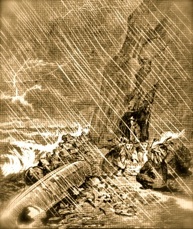
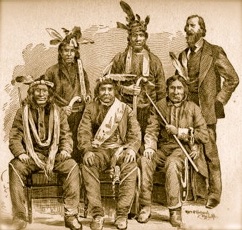
How did the sculptures come to be?
The clay modeling for the busts of Chief Buffalo of the Lake Superior Chippewa was done in February 1855. This was on a second trip to Washington that Buffalo made, after his first one with Benjamin Armstrong in 1852.
On his first trek, government agents tried to turn back the chief’s delegation. On this one, Buffalo and other Chippewa leaders arrived in Washington by invitation of the president. Buffalo was in the nation’s capital “in connection with the 1854 Treaty of La Pointe, in which the Chippewa agreed to accept reservation status. President Franklin Pierce in January 1855 requested a February audience with the principal Chippewa chiefs ‘to enter into additional articles of convention with them’ about their Minnesota lands and reservations.” That’s according to an article titled “Chief Buffalo and other Wisconsin-related Art in the National Capitol,” by John O. Holzhueter in the summer 1973 issue of the Wisconsin Magazine of History. The historian adds that despite Buffalo’s “advanced age he made the difficult overland winter journey from Lake Superior to a railhead several hundred miles to the south.”
A U.S. Senate document on the Capitol’s sculptures says: “The Senate possesses a remarkable pair of busts of Be sheekee (Buffalo) and Aysh-ke-bah-ke-ko-zhay (Flat Mouth) by the virtually unknown Italian sculptor Francis Vincenti. These Native American leaders came to Washington, D.C., in 1855 as part of a delegation responsible for negotiating a treaty.” Also noteworthy is this from the 1973 article: The figure of Buffalo was “one of only four identified Indians in the works of art in the Capitol.” It says the other three are Cherokee leader Sequoya, Pocahontas of the Powhatan tribe, and Chief Flat Mouth of the Pillager band of Minnesota Chippewa. Flat Mouth was part of the same 1855 trip that Buffalo made. (See the bottom of this page for more about Flat Mouth.)
‘I will have it put into marble and placed in a proper situation in the Capitol as a record of the Indian culture’
The Chippewa leaders in Washington captured the interest of Capt. Montgomery C. Meigs. He was was the superintendent in charge of the Capitol extension project underway at the time. Meigs wanted to send some modeling of American Indians to Rome to help guide Thomas Crawford, who had a commission to create new art for the Capitol. Meigs had “expressed concern to Crawford about the authenticity of Italian models for Indian figures,” according to the 1973 article from the Wisconsin Magazine of History. It’s unknown if Crawford ever received the models or casts. Buffalo received $5 to sit for three days for the clay model.
According to a U.S. Senate document on the Capitol’s sculptures, Meigs wrote in his journal at the time: “Vincenti is making a good likeness of a fine bust of Buffalo. I think I will have it put into marble and placed in a proper situation in the Capitol as a record of the Indian culture. 500 years hence it will be interesting.” Meigs added: “He is a fine-looking Indian. with character strongly marked.” The Senate’s biography of Buffalo says: “Be sheekee was chief of the La Pointe band of Ojibwa, located on Lake Superior in Wisconsin; he also led all the Lake Superior and Wisconsin bands of Ojibwa during much of this cultural transformation.”
U.S. Senate’s artistic description of the busts
Here’s how the U.S. Senate document on the Capitol’s sculptures describes the busts: “Be sheekee’s drilled eyes direct a forceful gaze slightly up and to his right, in an attitude of imperturbable alertness. There is nothing of frailty in the ancient head, and Vincenti modeled the expressive face firmly and broadly, even while faithfully recording the facial idiosyncrasies. The elaborate headdress undoubtedly attests to the sitter’s importance, as do the large ornaments suspended from the slit ears. Feathers are attached to the back of the head, and five short cylinders project hornlike on the crown of the head. Perhaps indicative of wooden originals, they are shown as if strapped to the head by a band that ties under the chin in a bow. The long braids of hair and strings of beads are vigorously carved, animating the stoic, penetrating likeness of Be sheekee. This formidable Native American was also called Great Buffalo, and the adjective was clearly deserved.”
The Senate document concludes: “The marble was carved in early 1856. The piece has been on view in the U.S. Capitol since its creation. In 1858 a related portrait bust was created in bronze by sculptor Joseph Lassalle, foreman of the Capitol’s bronze shop between 1857 and 1859. Not a replica of the Vincenti marble, but rather a new work based closely on the original clay model, Lassalle’s bust is displayed in the House wing of the Capitol.”
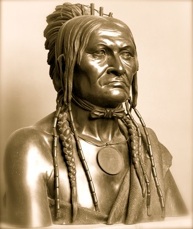
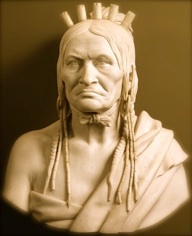
U.S. Capitol photographs

The Wisconsin Magazine of History in 1973 noted:
“The figure is Great Chief Buffalo (Bee-shekee or Bezhike) who headed the Lake Superior band of Chippewa Indians and who is one of only four identified Indians in the works of art in the Capitol.”
The Milwaukee Journal Sentinel in 1998 reported:
“The memory of Great Chief Buffalo is preserved in two very different places. One is in the weedy, rundown, often overlooked Indian Cemetery in La Pointe, on Madeline Island, near the fancy marina that shelters summer guests' expensive pleasure boats ... But Buffalo is remembered as well amid the splendor of the U.S. Capitol in Washington, where his image is part of the large art collection honoring historic figures. Great Chief Buffalo is one of three notable Wisconsin men represented; the others are Robert M. La Follette Sr. and Father Marquette.”
The Hill newspaper in 2011 reported:
“If staffers and tourists hurrying down the west staircase outside the House chamber were to look up, they’d be confronted by the steady gaze of a Native American chief. The same figure stares at the backs of the Senate’s workers and visitors turning out of the third-floor elevators near the upper chamber’s seated galleries. The chief’s name is Beshekee, or Buffalo, and two busts of him adorn either end of the Capitol.”
To read Peter Sullivan’s “The Marble Gaze of Chief Buffalo leads a growing Native American Art Collection,” click here
Web resources
To learn more about the Chief Buffalo busts, try these links:
For the U.S. Senate’s page on the Buffalo busts and his biography, click here
For a Government Printing Office version of the above document in a different format, click here
For “Chief Buffalo and other Wisconsin-related Art in the National Capitol,” by John O. Holzhueter in the summer 1973 issue of the Wisconsin Magazine of History, click here
The official U.S. Senate documents quoted on this page identify the busts as being likenesses of Chief Buffalo of the Lake Superior Chippewa. Some believe instead they are of the Leech Lake Chippewa chief of the same name. For the Chequamegon History blog on Wordpress has an entry titled, “Chief Buffalo Really Did Meet the President: The Vincent Roy Papers” that has more on this view, click here
Chief Buffalo wasn’t the only Chippewa leader from the 1855 delegation to Washington whose likeness was sculpted. The other was Chief Flat Mouth, or Aysh-ke-bah-ke-ko-zhay or Aish-ke-bo-go-ko-zhe. The chief was a leader of the Pillager Band of the Chippewa in the Leech Lake area of Minnesota.
The U.S. Senate’s biography of Chief Flat Mouth states he “spoke on behalf of his people in negotiating the cession of more than ten million acres in north-central Minnesota — a land package that included the headwaters of the Mississippi River ... Aspects of this cession and others in the region continued to figure in government discussions with Native Americans for the next hundred years.” It adds: “In 1911 Smithsonian Institution ethnologist James Moody characterized the great leader as ‘probably the most prominent Ojibwa chief of the upper Mississippi region from at least 1806 ... probably to his death, which seems to have occurred about 1860.’”
Who are the Pillagers?
The Pillager band was the leader of the Chippewa migration into Dakota/Sioux country and “developed warrior traditions over the years that persisted much longer than among Chippewa bands ... By 1870 the Pillagers had accepted a reservation in the lands they won from the Dakota and most of them lived in villages on the shores of Leech, Cass and Winnebigoshish lakes,” according to “The Chippewa: A History of the Great Lakes Woodland Tribe over Three Centuries” by Walker D. Wyman.
The Pillagers were involved in what’s been called the last Indian uprising in the United States. The Pillager Uprising — also known as the Leech Lake Uprising and the Battle of Sugar Point — occurred in October 1898 when 3rd Regiment U.S. Infantry troops were called in. There were a variety of circumstances that led up to the uprising, including the arrest of tribal members on minor charges. The Pillagers won the battle with no deaths. Numerous U.S. soldiers were killed. One report says the federal government later investigated the tribe’s complaints and found that state and local authorities had been committing wrongs and engaging in unfair treatment against tribal members. One theory about why the Leech Lake Uprising didn’t receive more attention is because the United States had emerged out of the Spanish-American War that same year and the media focus was elsewhere.

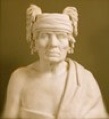
What about the bust of Chief Flat Mouth
of the Pillager band?

U.S. Capitol photograph
For more details on Flat Mouth’s bust from the Senate’s Web site, click here
For the Web site of the Leech Lake Band of Ojibwe, click here
For Wikipedia’s entry on the Pillager Uprising, click here
Also, see this Web site’s “Sandy Lake Tragedy” page for more on Chief Flat Mouth.
This site is published by a member of the Minnesota Chippewa Tribe. Click here for more information
